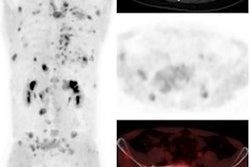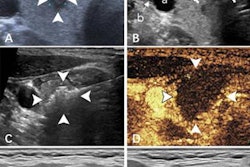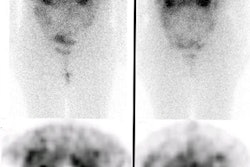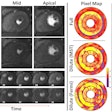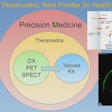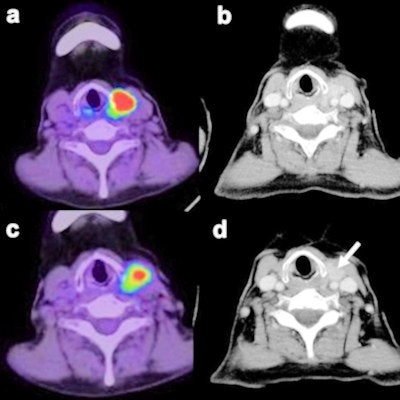
PET/CT scans in patients with advanced thyroid cancer can predict their response to lenvatinib just one week after they begin treatment -- much faster than contrast-enhanced CT (CECT) exams, according to researchers in Japan.
A group led by Dr. Satoshi Takeuchi, PhD, of Hokkaido University in Sapporo, found that F-18 FDG-PET/CT scans predicted patient response one week after initiation of lenvatinib (Lenvima). This is significantly earlier than gold standard CE-CT scans performed four weeks after treatment initiation, they noted.
"If FDG-PET/CT can predict treatment outcomes at an early time point after treatment initiation, it can be useful to avoid adverse effects and high treatment costs in advance," the group wrote, in an article published July 17 in EJNMMI Research.
Kinase inhibitors such as lenvatinib have shown promise in patients with differentiated thyroid cancer after initial treatments have failed, yet these drugs are expensive and associated with several unique adverse events, the authors explained. Moreover, methods for predicting treatment outcomes in patients receiving the drugs are limited, they added.
To that end, the researchers aimed to determine whether early F-18 FDG-PET/CT scans are effective for determining patient response.
The researchers recruited 21 patients between June 2016 and March 2020 with pathologically confirmed differentiated thyroid carcinoma. Patients were treated with 24 mg of lenvatinib as the initial dose and underwent PET/CT examination one week later. The primary endpoint of the study was the predictive value of maximum standardized uptake value (SUVmax) of FDG radiotracer in tumors, as assessed by a nuclear medicine physician and a diagnostic radiologist.
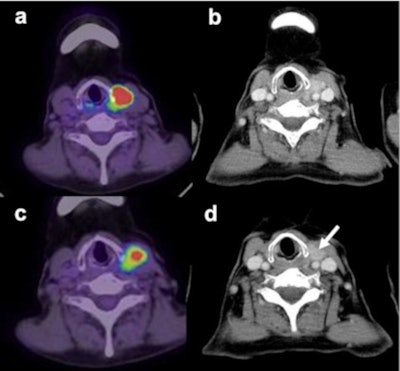 Imaging findings in 67-year-old patient with papillary carcinoma undergoing PET/CT and contrast-enhanced CT. At the initial treatment, PET/CT (a) and contrast-enhanced (b) showed a 2 cm primary tumor in the left thyroid with an SUVmax of 48.7. Systemic chemotherapy with a lenvatinib dose of 24 mg was initiated as the first-line therapy. After 1 week of treatment with lenvatinib, PET/CT (c) demonstrated a remarkable decline in SUVmax to 24.2. However, the mass is still visualized on contrast-enhanced CT (d) performed 4 weeks after treatment (arrow). The patient was alive for more than six years after treatment. Image courtesy of EJNMMI Research through CC BY 4.0.
Imaging findings in 67-year-old patient with papillary carcinoma undergoing PET/CT and contrast-enhanced CT. At the initial treatment, PET/CT (a) and contrast-enhanced (b) showed a 2 cm primary tumor in the left thyroid with an SUVmax of 48.7. Systemic chemotherapy with a lenvatinib dose of 24 mg was initiated as the first-line therapy. After 1 week of treatment with lenvatinib, PET/CT (c) demonstrated a remarkable decline in SUVmax to 24.2. However, the mass is still visualized on contrast-enhanced CT (d) performed 4 weeks after treatment (arrow). The patient was alive for more than six years after treatment. Image courtesy of EJNMMI Research through CC BY 4.0.According to a receiver operating characteristic (ROC) curve analysis, SUVmax on PET/CT scans predicted patient response with an area under the ROC of 0.714 after one week of treatment. The best cut-off value for the treatment response for SUVmax was 15.2, with a sensitivity of 58% and specificity of 86% for this cut-off value, they found.
In addition, the median progression-free survival was 26.3 months in patients using a cut-off value under 15.2 and 19.7 months in patients using a cut-off value above 15.2 (p = 0.078), according to the results.
"These patients may benefit from the results of this study, as we aimed to predict treatment outcomes earlier than with conventional CT using FDG-PET/CT," the researchers noted.
The results are promising yet challenging, the authors noted. While discontinuing lenvatinib treatment for patients if an early treatment response is suggested by FDG PET/CT findings, limited alternative treatment options are available for these patients, they wrote.
"This result warrants further study to prevent adverse effects and high treatment costs," the group concluded.
The full article can be found at EJNMMI Research.






